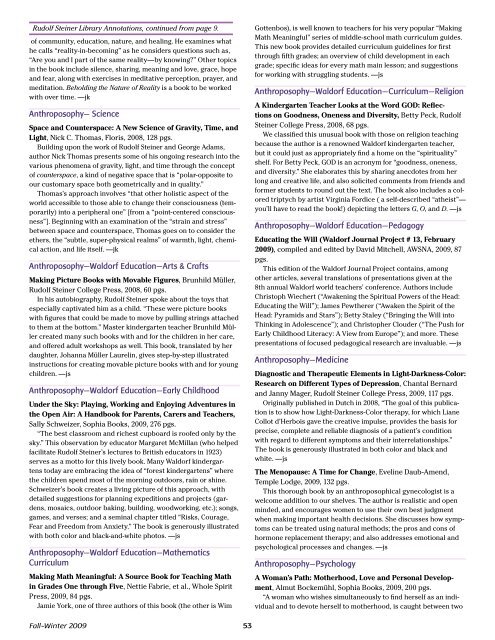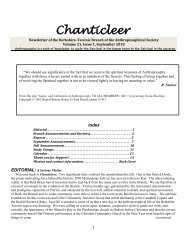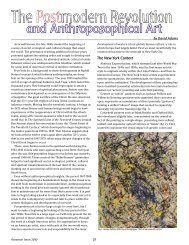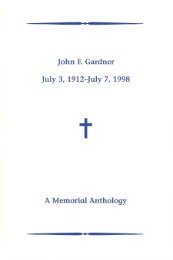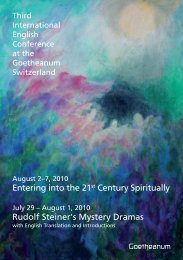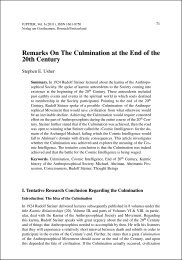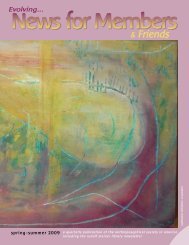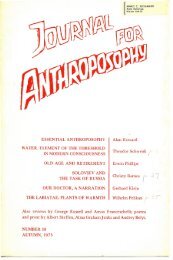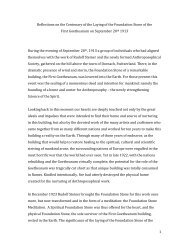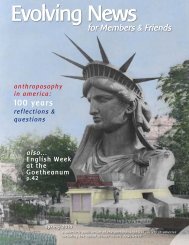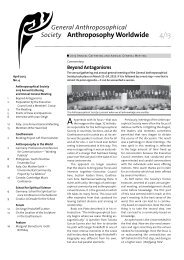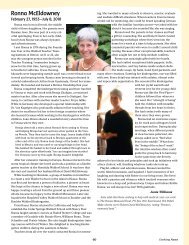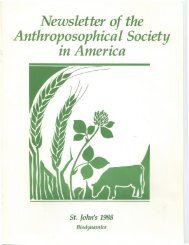& Friends - Anthroposophical Society in America
& Friends - Anthroposophical Society in America
& Friends - Anthroposophical Society in America
Create successful ePaper yourself
Turn your PDF publications into a flip-book with our unique Google optimized e-Paper software.
Rudolf Ste<strong>in</strong>er Library Annotations, cont<strong>in</strong>ued from page 9.of community, education, nature, and heal<strong>in</strong>g. He exam<strong>in</strong>es whathe calls “reality-<strong>in</strong>-becom<strong>in</strong>g” as he considers questions such as,“Are you and I part of the same reality—by know<strong>in</strong>g?” Other topics<strong>in</strong> the book <strong>in</strong>clude silence, shar<strong>in</strong>g, mean<strong>in</strong>g and love, grace, hopeand fear, along with exercises <strong>in</strong> meditative perception, prayer, andmeditation. Behold<strong>in</strong>g the Nature of Reality is a book to be workedwith over time. —jkAnthroposophy— ScienceSpace and Counterspace: A New Science of Gravity, Time, andLight, Nick C. Thomas, Floris, 2008, 128 pgs.Build<strong>in</strong>g upon the work of Rudolf Ste<strong>in</strong>er and George Adams,author Nick Thomas presents some of his ongo<strong>in</strong>g research <strong>in</strong>to thevarious phenomena of gravity, light, and time through the conceptof counterspace, a k<strong>in</strong>d of negative space that is “polar-opposite toour customary space both geometrically and <strong>in</strong> quality.”Thomas’s approach <strong>in</strong>volves “that other holistic aspect of theworld accessible to those able to change their consciousness (temporarily)<strong>in</strong>to a peripheral one” [from a “po<strong>in</strong>t-centered consciousness”].Beg<strong>in</strong>n<strong>in</strong>g with an exam<strong>in</strong>ation of the “stra<strong>in</strong> and stress”between space and counterspace, Thomas goes on to consider theethers, the “subtle, super-physical realms” of warmth, light, chemicalaction, and life itself. —jkAnthroposophy—Waldorf Education—Arts & CraftsMak<strong>in</strong>g Picture Books with Movable Figures, Brunhild Müller,Rudolf Ste<strong>in</strong>er College Press, 2008, 60 pgs.In his autobiography, Rudolf Ste<strong>in</strong>er spoke about the toys thatespecially captivated him as a child. “These were picture bookswith figures that could be made to move by pull<strong>in</strong>g str<strong>in</strong>gs attachedto them at the bottom.” Master k<strong>in</strong>dergarten teacher Brunhild Müllercreated many such books with and for the children <strong>in</strong> her care,and offered adult workshops as well. This book, translated by herdaughter, Johanna Müller Laurel<strong>in</strong>, gives step-by-step illustrated<strong>in</strong>structions for creat<strong>in</strong>g movable picture books with and for youngchildren. —jsAnthroposophy—Waldorf Education—Early ChildhoodUnder the Sky: Play<strong>in</strong>g, Work<strong>in</strong>g and Enjoy<strong>in</strong>g Adventures <strong>in</strong>the Open Air: A Handbook for Parents, Carers and Teachers,Sally Schweizer, Sophia Books, 2009, 276 pgs.“The best classroom and richest cupboard is roofed only by thesky.” This observation by educator Margaret McMillan (who helpedfacilitate Rudolf Ste<strong>in</strong>er’s lectures to British educators <strong>in</strong> 1923)serves as a motto for this lively book. Many Waldorf k<strong>in</strong>dergartenstoday are embrac<strong>in</strong>g the idea of “forest k<strong>in</strong>dergartens” wherethe children spend most of the morn<strong>in</strong>g outdoors, ra<strong>in</strong> or sh<strong>in</strong>e.Schweizer’s book creates a liv<strong>in</strong>g picture of this approach, withdetailed suggestions for plann<strong>in</strong>g expeditions and projects (gardens,mosaics, outdoor bak<strong>in</strong>g, build<strong>in</strong>g, woodwork<strong>in</strong>g, etc.); songs,games, and verses; and a sem<strong>in</strong>al chapter titled “Risks, Courage,Fear and Freedom from Anxiety.” The book is generously illustratedwith both color and black-and-white photos. —jsAnthroposophy—Waldorf Education—MathematicsCurriculumMak<strong>in</strong>g Math Mean<strong>in</strong>gful: A Source Book for Teach<strong>in</strong>g Math<strong>in</strong> Grades One through Five, Nettie Fabrie, et al., Whole SpiritPress, 2009, 84 pgs.Jamie York, one of three authors of this book (the other is WimFall-W<strong>in</strong>ter 200953Gottenbos), is well known to teachers for his very popular “Mak<strong>in</strong>gMath Mean<strong>in</strong>gful” series of middle-school math curriculum guides.This new book provides detailed curriculum guidel<strong>in</strong>es for firstthrough fifth grades; an overview of child development <strong>in</strong> eachgrade; specific ideas for every math ma<strong>in</strong> lesson; and suggestionsfor work<strong>in</strong>g with struggl<strong>in</strong>g students. —jsAnthroposophy—Waldorf Education—Curriculum—ReligionA K<strong>in</strong>dergarten Teacher Looks at the Word GOD: Reflectionson Goodness, Oneness and Diversity, Betty Peck, RudolfSte<strong>in</strong>er College Press, 2008, 68 pgs.We classified this unusual book with those on religion teach<strong>in</strong>gbecause the author is a renowned Waldorf k<strong>in</strong>dergarten teacher,but it could just as appropriately f<strong>in</strong>d a home on the “spirituality”shelf. For Betty Peck, GOD is an acronym for “goodness, oneness,and diversity.” She elaborates this by shar<strong>in</strong>g anecdotes from herlong and creative life, and also solicited comments from friends andformer students to round out the text. The book also <strong>in</strong>cludes a coloredtriptych by artist Virg<strong>in</strong>ia Fordice ( a self-described “atheist”—you’ll have to read the book!) depict<strong>in</strong>g the letters G, O, and D. —jsAnthroposophy—Waldorf Education—PedagogyEducat<strong>in</strong>g the Will (Waldorf Journal Project # 13, February2009), compiled and edited by David Mitchell, AWSNA, 2009, 87pgs.This edition of the Waldorf Journal Project conta<strong>in</strong>s, amongother articles, several translations of presentations given at the8th annual Waldorf world teachers’ conference. Authors <strong>in</strong>cludeChristoph Wiechert (“Awaken<strong>in</strong>g the Spiritual Powers of the Head:Educat<strong>in</strong>g the Will”); James Pewtherer (“Awaken the Spirit of theHead: Pyramids and Stars”); Betty Staley (“Br<strong>in</strong>g<strong>in</strong>g the Will <strong>in</strong>toTh<strong>in</strong>k<strong>in</strong>g <strong>in</strong> Adolescence”); and Christopher Clouder (“The Push forEarly Childhood Literacy: A View from Europe”); and more. Thesepresentations of focused pedagogical research are <strong>in</strong>valuable. —jsAnthroposophy—Medic<strong>in</strong>eDiagnostic and Therapeutic Elements <strong>in</strong> Light-Darkness-Color:Research on Different Types of Depression, Chantal Bernardand Janny Mager, Rudolf Ste<strong>in</strong>er College Press, 2009, 117 pgs.Orig<strong>in</strong>ally published <strong>in</strong> Dutch <strong>in</strong> 2008, “The goal of this publicationis to show how Light-Darkness-Color therapy, for which LianeCollot d’Herbois gave the creative impulse, provides the basis forprecise, complete and reliable diagnosis of a patient’s conditionwith regard to different symptoms and their <strong>in</strong>terrelationships.”The book is generously illustrated <strong>in</strong> both color and black andwhite. —jsThe Menopause: A Time for Change, Evel<strong>in</strong>e Daub-Amend,Temple Lodge, 2009, 132 pgs.This thorough book by an anthroposophical gynecologist is awelcome addition to our shelves. The author is realistic and openm<strong>in</strong>ded, and encourages women to use their own best judgmentwhen mak<strong>in</strong>g important health decisions. She discusses how symptomscan be treated us<strong>in</strong>g natural methods; the pros and cons ofhormone replacement therapy; and also addresses emotional andpsychological processes and changes. —jsAnthroposophy—PsychologyA Woman’s Path: Motherhood, Love and Personal Development,Almut Bockemühl, Sophia Books, 2009, 200 pgs.“A woman who wishes simultaneously to f<strong>in</strong>d herself as an <strong>in</strong>dividualand to devote herself to motherhood, is caught between two


